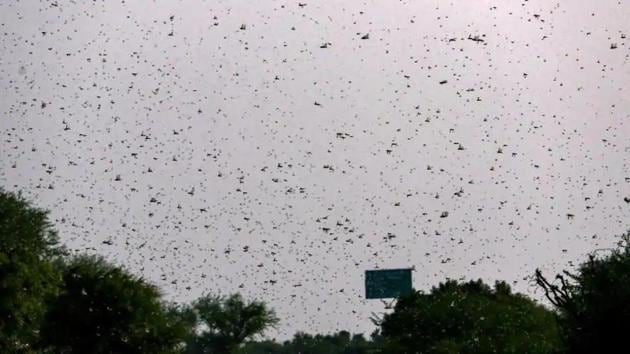High alert sounded in south, southwest Delhi for potential locust attack
The city-state’s agriculture department issued advisories to all district magistrates, sub-divisional magistrates, the forest department and municipal corporations to prepare for locust swarms.
Delhi’s environment minister Gopal Rai on Saturday issued a high alert in south and southwest districts of the city because of a potential locust attack threat after a small portion of a locust swarm moving towards Palwal in Haryana entered the Asola Bhatti area.

The city-state’s agriculture department issued advisories to all district magistrates, sub-divisional magistrates, the forest department and municipal corporations to prepare for locust swarms.
After scattered groups of locusts entered Delhi’s border areas including Aya Nagar and Mehrauli, Rai called an emergency meeting at noon on Saturday to discuss the locust threat.
The forest department was directed to take measures such as creating high-decibel noise through beating of drums or loud music to scare away the locusts. All district magistrates were asked to remain in touch with the fire department to make arrangements for chemical spraying to save vegetation from the voracious pests.
“The DMs have also been asked to deploy adequate staff to make all possible arrangements like Munadi in the villages to guide the residents to distract the locals by making high decibel sound through banging of utensils, beating drums, playing DJs or burning of neem leaves,” the advisory said.
Residents of some parts of south Delhi were taken aback when they saw the skyline turning brown around noon.
Sanat Swain, a mechanical engineer who was driving to his workplace in Gurugram, saw a large number of locusts near the Indian Institute of Technology flyover. “I was driving and I couldn’t believe what was happening. The sky above me had turned dark brown suddenly,” he said.
Northwest India is bracing for more such swarms. Several swarms have flown in from Pakistan and Iran in the past 10 to 15 days after breeding took place there nearly all year round, the Locust Warning Organisation said.
The swarm, which had originally started from Pakistan, came via Jhunjhunu in Rajasthan and Rewari in Haryana and reached Gurugram around noon. Before heading towards Palwal, parts of the swarm crossed several stretches of south Delhi.
According to the LWO, during locust control operations in Rajasthan, this particular swarm survived the insecticides sprayed on them so they started moving from there and headed towards Gurgaon with the wind direction being predominantly westerly.
On Saturday afternoon, the swarm reached Bulandshahr in Uttar Pradesh and a few scattered groups remained in Delhi. LWO’S seven ground control vehicles were headed towards Bulandshahr where control operations are likely to take place.
“These vehicles are mounted with machines that have sprayers. Drones and tractors or fire brigades will also be used. We will spray Malathion 96, Lambda Cyhalothrin and Chlorpyrifos to control the swarm at night in UP,” said KL Gurjar, deputy director, LWO.
“We can’t conduct our control operations until they settle down. They could settle in some remote areas around 8 pm,” said JP Singh, joint director, LWO. Spraying of pesticides could take place only after midnight.
Meanwhile, with the monsoon approaching the arid regions of Rajasthan, breeding of locusts has started in several pockets, Gurjar said. “Egg laying has taken place and hoppers have emerged. But we will manage to control these hoppers immediately,” Gurjar added.
Last week, the Food and Agriculture Organisation had warned that Ethiopia, South Sudan, Pakistan, and India should remain on high alert during the next four weeks for fresh locust invasions. Any swarms in northern Somalia can migrate across the Indian Ocean to the summer breeding areas along both sides of the Indo-Pakistan border.
“There are successive breeding cycles in the Horn of Africa. Some swarms from there are moving towards west Africa while some are moving towards Saudi Arabia, Oman and Yemen. These can also come to India in July. Some are expected to directly move to India from the Horn of Africa with the monsoon winds,” Gurjar said.
“The winds are moving from the direction of the Horn of Africa towards India. The wind direction is south-westerly during monsoon. I will not be able to comment on whether they will carry these swarms with them,” said M Mohapatra, director general, India Meteorological Department.
LWO said the Kharif crop, especially maize and cotton, is likely to be impacted if the two locust threats—from the Indian Ocean and from breeding sites in India -- aren’t controlled






